Route 8
The Mystery and Origin of the Maya Culture
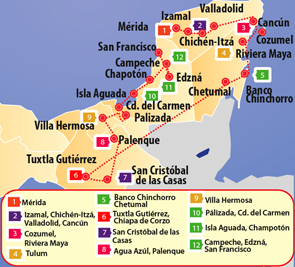
Merida
If there is a corner in Mexico that managed to capture the European splendor of the beginning of the 20th Century, it has to be the Montejo Avenue in Mérida. The magnificence of estates on this avenue reminds us of a bonanza that is hard to imagine today. Beyond the splendor, which was the result of the henequen (a type of plant used for rope making) export peak, Merida is a Colonial city, rich in cultural traditions and with a very special gastronomy, featuring delicacies as original as panuchos, papadzules or queso relleno.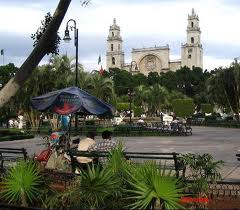
It is almost a sin to travel to Merida and return empty-handed; you must buy a huipil, a shawl, a hammock or a guayabera. The whole universe of Yucatec handicraft culture can be found in this city, although, like anywhere else, you must look carefully. The best places can be found by just asking, particularly for hammocks and the very famous shirts, guayaberas. Other articles that stand out are those made with henequenfibers, from table cloths to vases. Filigree work and ceramics are also materials used by local expert artisans.
In Mérida, Yucatán’s huge gastronomic tradition coincides with the character of a city open to the world. Therefore, it is possible to have access both to places with a long tradition and to those devoted to reinventing the Yucatec palate. Here, you will find everything from the traditional papadzule and cochinita pibil, to venison soup and also Italian carpaccio, Lebanese kebbe and Angus meat cuts. Eating well in Mérida is very simple, just go virtually anywhere, choose practically anything, and have your meal.
Out of all the traditional markets in Merida – like Chen Bech, Garcia Rejon or San Benito – the most diverse for the visitor is probably the Lucas de Galvez market. Originally from the 19th Century and demolished on different occasions, the market has been located in the same spot since 1958, and it concentrates everything: habanero chilies, panuchos, papadzules, cochinita, honey liquor, jewelry, handicrafts and even Yucatec huaraches (sandals). In the Garcia Rejon bazaar, the specialty are handicrafts and in San Benito, all sorts of souvenirs or mementos.
Merida is mirror and synthesis of Yucatec traditions. The warmth of its people explodes in popular festivities known as Vaquerias, which happen in the neighborhoods when the date is right. These offer a spectacle by women of colorful huipiles and filigree rosaries, and men with his guallaberas and alpargatas half notes. Another occasion – an afternoon of having coffee at one of the plazas – will allow us to enjoy the romantic and quivering Yucatec song. Walking around the city, look out for the corners; it is an old tradition in Merida to name each one of them.
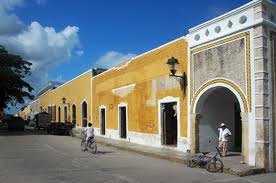 Izamal
Izamal
It is called “the yellow city” and you don’t need anything else than one look at it to realize that the name is a very literal reference. But the most impressive thing about this small Colonial town is its huge convent, with an enormous open chapel, designed to evangelize the largest number of indigenous people. Izamal is famous because of the cultural mix it has, and from the convent of Nuestra Señora de Izamal, you can see a series of mountains that are in fact none other than Mayan pyramids that surround the town.
Around 1553, the Conquerors decided to build a convent over a pyramid in Izamal, resorting to a well-known tactic. They probably thought that the spirit of Itzamna, ruling god of the Itzaes, would be conjured, and that could perchance cancel his memory. Kinich Kak Moo, the great pyramid here, survived this building effort and from its 10 levels it reminds us, in essence, Pre-Hispanic rites. We can only speculate what Pap-Hol-Chac was like before the arrival of the Franciscans, and imagine what gods rest under the convent of San Antonio de Padua.
In Izamal’s stamp one can decipher Mexico’s history, a mestizo and devout present built on a long Pre-Hispanic tradition. The 12 hills that shape it correspond to the ancient Maya settlement, which was partially dismantled to erect the Colonial buildings. The convent complex of Nuestra Señora de Izamal, which received the visit of Pope John Paul the 2nd in 1992, is the best example, built on an indigenous temple. In 2002, this town was named Pueblo Magico: its fascinating history and pastoral beauty demanded it.
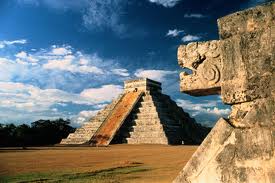 Chichen Itza
Chichen Itza
It may well be that today it is one of the new wonders of the world, but the truth is that in Mexico, we have known for a long time that few things can match this Mayan city that hides in the heart of the Yucatan Peninsula. The enormous complex at Chichén Itza and the architectural beauty of its edifices convince visitors of a single thing: the Maya were an advanced culture rivaled by few.
It could have been from the heights of the Castle or on the edge of the Sacred Cenote, but someone, some time, experienced the splendor of Chichen Itza and understood that an era was coming to an end. The city was the epicenter of the Maya Post-Classic period, when the north was beginning to exercise its influence. Thus, Kukulcan replaced Ixbalanque and Hunahpu, and the long ornamental tops of Palenque became solid Toltec severity. A metropolis of large ball game courts, public baths, observatories and colonnades, the evolution of Mayan people can be guessed in this “well opening of water sorcerers”.
Informally recognized as one of the seven New Wonders of the World, Chichen Itza rises in Tinum, near the heart of Yucatan. Another more thorough designation preceded it, when UNESCO included it in its World Heritage Site list in 1988. This decision, to be sure, was simple: throughout the nearly one thousand years of history, the city was chronicler of the Mayan civilization. Its architecture reveals the fusion with Toltec culture. In its layout and reliefs, a change in order is outlined, a precise science and a permanent message to the gods.
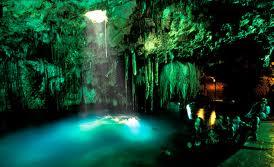 Valladolid
Valladolid
At the heart of the Yucatan Peninsula, this Colonial city is famous for its architecture and its very rich gastronomy full of different flavours and ingredients. Although for many it is only one more step in the route, since it connects Mérida with the Riviera Maya, the truth is that visiting this city is an experience that combines very well the Maya spirit of the peninsula with the Colonial legacy of the architecture. In addition, there are at least a dozen cenotes (sink holes formed in lime rock) that are worth exploring.
Let us start from the beginning. Cochinita pibil, papadzules and black relleno are the traditional starting points for Valladolid’s gastronomy. They are accompanied by lime soup, queso relleno and turkey mechado. The famous lomitos and poc chuc here – another configuration of Yucatec pork – complete the route. Let’s make a pause: Yucatec cuisine is so vast and particular that one volume would not be enough to cover it all. In this city, you will find the perfect occasion to explore it at length, or die from pleasure when trying.
Cancun
Cancun is a planned paradise, and this is evident when travelling along its enormous costera (coastal road), where some of the largest hotels in the country are found. What was once a fishing town is today a city full of life and opportunities. The entertainment options here are designed to satisfy all interests, and that’s why you have a choice between spending the afternoon shopping around or practicing extreme sports in a thematic park in the area.
Cancun is probably the most vibrant and cosmopolitan city in the Caribbean and its culinary offer reflects it. In this city, you can find anything you want, in any form and for all preferences. There will be Yucatec food, naturally, as in the whole peninsula, but you will also find – among many other – excellent Thai, Italian or Argentine options. From a sushi bar to a world-class restaurant, in any one of the most exclusive hotels, in Cancun the right question to ask when one is hungry is simply: what do you want to eat today?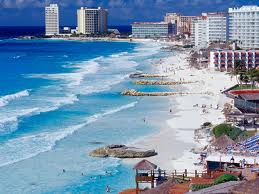
North of Cancun, towards the spectacular island of Holbox, the Yum Balam Flora and Fauna Protection Area is located; it is a reserve of 150 thousand hectares that extends over the island, the lagoon and the surrounding mangroves, which, in its jungle area protects five threatened feline species, including the puma and the jaguar. Given the astonishing diversity in the area’s marine life, during the summer it is also possible to see the largest guest: the whale shark. Currently, transportation to the watching area also departs from Cancun, from Punta Sam.
In the minds of a good many people all over the world, Cancun is, almost by definition, what it means to be a “great beach destination”. This fame is well deserved, since it is big in size and offer; it is an international destination and it is a beach in every sense of the word. Besides the kilometers of white beach that surround Nichupte lagoon, the city also offers the paradises in the islands. In Holbox: fishing vibe and virgin sands; in Isla Pajaros, immediate nature; and in Isla Mujeres, all the romance of the Caribbean.
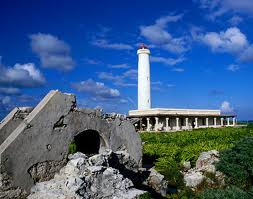 Cozumel
Cozumel
One of the best kept secrets in Mexico is hidden in the waters that surround this small island, quite near the coast of Playa del Carmen. As many other locations in the Caribbean, the sea wealth in Cozumel is great, but here, for some reason, it is easier to simply find it. You will need a pair of flippers, a snorkel and very little courage, since only a few meters from the coast there is an underwater universe to be discovered, of spectacular beauty.
Various pilgrimages from the Yucatan Peninsula used to arrive in the place that now occupies the archaeological site of San Gervasio, with the intention of honoring Ixchel, goddess of fertility. These processions, of course, were over land and by sea, and they traced their last steps over “white paths” – the famous sacbes – which connect the different architectural groups in the place of worship. Cozumel also houses, particularly to the north, other interesting archaeological sites, but none of them projected from the island as deeply, all over the Maya.
The knowledgeable traveler does not visit Cozumel, but rather the sea around the island. Under this sea, there is a sunken paradise, the 25 coral formations called Arrecifes de Cozumel National Park. Animal life in its surroundings is just as fantastic: eels, barracudas, rays, turtles and a multitude of other water species. Particularly stunning are the Colombia, Palancar and Santa Rosa coral reefs, for there is a constant current that makes diving easy and magnificent marine life. Visiting at night is, truly, the pinnacle of intense experiences.
The best beaches in Cozumel do not look towards the Mayan Riviera, for they face the Caribbean Sea. Since they are located on the eastern part of the island, they are somewhat far from the usual landing place, which is always the growing city of San Miguel. This should not intimidate us, because with a rented scooter, Punta Morena, Chen Rio or Playa Bonita is pretty close. However, the true attraction is undersea, in the surrounding waters, for there are myriad reefs, corals and marine fauna waiting. Bring sunscreen to the island, and also a diving mask and snorkel.
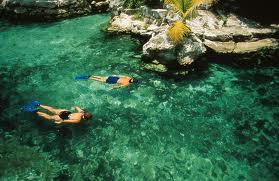 Riviera Maya
Riviera Maya
From the northern tip of the Yucatan Peninsula to the sandy and blue Bacalar Lagoon, the Riviera Maya is a destination that conquers visitors at first sight. White beaches and turquoise waters extend for kilometers and offer all sorts of attractions along this stretch (and for every taste). Recognized internationally for its beauty, it is quite likely that the infrastructure found in this area does not exist anywhere else in the country. From cruise ships to boutique and luxury tourism, options are endless. In addition, the Maya past – hidden in sites like Tulum, with the only pyramid that rises next to the sea – complement the travelera’s experience.
On the Mayan Riviera, it is possible to enjoy three different versions of archaeological tourism. The first is in amusement parks. In the neighboring areas, you can visit the vestiges of Pole, which ancient Maya people occupied as a port, worship place and commercial city. The second version, more sober and probably more beautiful, awaits at the foot of the Tulum bastions, which is the point where Maya stone touched the sea. The third option, rather adventurous, would be the massive Coba, whose extension was so great that its limits may never be known with certainty.
In each one of the towns on the Mayan Riviera, there is a particular way of having a meal. In the smaller ones, like Puerto Madero or Punta Allen, the usual is artisan cuisine, depending on what is brought in from the fish. In the famous and very busy places, the offer is extremely varied, as it should be in an important tourist destination. Playa del Carmen is the best example of the latter, and in its locales you can find everything from health food to the Mayab flavor, as well as Thai, Italian, typical beach food and, yes, even Swedish.
Sian Ka’an became a World Heritage Site in 1987. The natural reserve protects, in its half million hectares, more than two thousand types of plants, hundreds of flower and bird species, and a showcase of animals in danger of extinction. But it is not only that, for beaches of calm beauty are unveiled next to the exuberant landscape; it is a privileged spot for fishing and it even includes its own archaeological vestiges. This stretch of jungle, swamps and mangroves is called “the place where heaven begins”, an accurate christening for an exceptional place.
The Mayan Riviera offers the possibility of exploring every adequate configuration for what is understood as beach. Warm, intimate and fit for fishing: Puerto Madero. Hipster, gourmet and with a thriving nightlife: Playa del Carmen. Endless, inexhaustible, and perhaps unbelievable: the crescent-shaped Akumal. Of Mayan tongue, cenotes and archaeological zones: Tulum. Sporty, ecological and fit for great fishing: the always professional Punta Allen. And, naturally, the beach according to God or nature’s original plan at the, still virgin, Sian Ka’an Reserve.
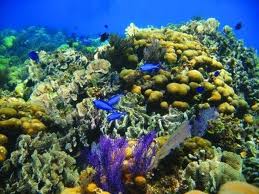 Banco Chinchorro
Banco Chinchorro
Banco Chinchorro is the second largest atoll in the world. Chinchorro’s 70 kilometers are surrounded by a coral reef that represents a great theme park for divers and snorkeling fanatics. This part of the Xcalak reserve once served as natural barrier against ships – and hiding place for pirates. This is why divers who explore its waters can observe vestiges of shipwrecks, in addition to the natural beauty.
On the Caribbean Sea, Banco Chinchorro emerges in front of the coast of Quintana Roo, considered one of the largest atolls in the world. It is located in the vicinity of the second largest coral formation in the planet and, in recent times, it was declared to be a protected natural reserve. It houses areas where different turtles lay eggs – caguama, carey and white – and it is a nesting place for birds and fish. The waters there, it is said, hide treasures from the times of galleons; there is hardly a more beautiful place in the seas to be wrecked.
The only way to gain access to Banco Chinchorro is with help from fishermen, who camp there during season to catch shrimp and lobster. It goes without saying that the visit is worth your while: 22 kilometers of coast wait for you, flanked by the reefs. From the towns of Mahahual and Xcalak, you can hire the crossing and also find extremely beautiful beaches. Their ambiance is of traditional fishing towns. There, you can opt for ecotourism or for the kind of relaxation that you only get by dipping your feet in the sea and the look in the horizon.
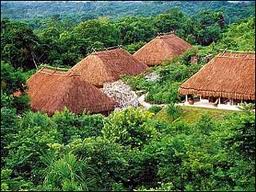 Chetumal
Chetumal
The capital of Quintana Roo is possibly one of the less explored destinations in the region, since the huge tourist development to the north has eclipsed this area. And this is recent history, for during Colonial times the Spanish in the end resigned in trying to colonize these lands with difficult access, and left control of the region to the Maya. This is why Chetumal is, in principle, a rather recent city, and in spite of its importance as economic center for Central America, the city maintains the calm and relaxed spirit of a town.
Chetumal has a double travelling personality, for it is port and also border; its food reflects this vocation carefully. From the British side, via Belize, it received the names “rice and beans” and “meat pie” for certain dishes: the first is red rice with fried plantains, chicken or fish; the second, ground beef with chili prepared in meatloaf. From the peninsula, it received xpelon tamales and fish tikinxic style. Locally, fruit machacados; and there is also Chinese food, and food from Mexico’s north and center. Eating in Chetumal means eating in many places.
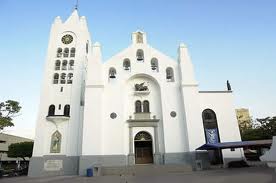 Tuxtla Guiterrez
Tuxtla Guiterrez
The Mexican entrance to Central America is this Chiapas city, which has also been a cultural center for the region, partly because the poet Jaime Sabines who was born here, left an important Cultural Center to the city. Tuxtla, which bubbles with the comings and goings of travelers that cross the city every day, also hides the monumental beauty of the Cañón del Sumidero (Sumidero Canyon), a crevice where the Grijalva river runs, at a depth of more than one kilometer.
Sumidero Canyon (Spanish: Cañón del Sumidero) is a narrow and deep canyon surrounded by a national park 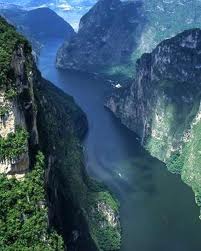 located just north of the city of Tuxtla Gutiérrez in the Mexican state of Chiapas. This Canyon is an explosion of greenery, water and wildlife. It begins near the city of Chiapa de Corzo, stretches for about 35km, crossing a number of impressive cliffs, finally ending at the reservoir of the hydroelectric dam Chicoasen. The canyon’s creation began around the same time as the Grand Canyon in the U.S. state of Arizona, by a crack in the area’s crust and erosion by the Grijalva River, which still runs through it. The canyon has vertical walls which reach as high as 1000 meters, with the river turning up to ninety degrees during the thirteen kilometers that the narrow passage runs. At the north end of the canyon is the Chicoasén Dam, one of several on the Grijalva River and important for water storage and the generation of hydroelectricity. Surrounding the canyon is the Sumidero Canyon National Park, which extends for 21,789 hectares over four municipalities of the state of Chiapas. This park is administered by the Comisión Nacional de Áreas Naturales Protegidas (Conanp). Most of the vegetation of this park is low to medium height deciduous rainforest, with small areas of pine/oak trees and grassland.
located just north of the city of Tuxtla Gutiérrez in the Mexican state of Chiapas. This Canyon is an explosion of greenery, water and wildlife. It begins near the city of Chiapa de Corzo, stretches for about 35km, crossing a number of impressive cliffs, finally ending at the reservoir of the hydroelectric dam Chicoasen. The canyon’s creation began around the same time as the Grand Canyon in the U.S. state of Arizona, by a crack in the area’s crust and erosion by the Grijalva River, which still runs through it. The canyon has vertical walls which reach as high as 1000 meters, with the river turning up to ninety degrees during the thirteen kilometers that the narrow passage runs. At the north end of the canyon is the Chicoasén Dam, one of several on the Grijalva River and important for water storage and the generation of hydroelectricity. Surrounding the canyon is the Sumidero Canyon National Park, which extends for 21,789 hectares over four municipalities of the state of Chiapas. This park is administered by the Comisión Nacional de Áreas Naturales Protegidas (Conanp). Most of the vegetation of this park is low to medium height deciduous rainforest, with small areas of pine/oak trees and grassland.
San Cristobal de las Casas
In San Cristobal, more than foreigners, there are converts: travelers who arrived here and fell in love with this Colonial town with a Pre-Hispanic spirit. By simply visiting its markets one can observe that, the wealth of local cultures has found a space for expression in this place, definitively a place to be seen. From the typical attire, made of textiles full of color and different styles, you can recognize the diversity of its people. Here, the Spanish heritage can be witnessed in the architecture and culture.
The convergence of different Chiapas ethnic groups has given San Cristobal a vein of artisan wealth without comparison. Along its tourist walkway, it is possible to find exquisite jewelry pieces made of amber or jade, delicate examples of filigree or complicated works in forged steel. Whether in commercial galleries or in the street market – which gathers daily in front of the Santo Domingo church – the collector will have access to a wide array of ceramics, woodwork and textiles, all examples of proverbial Mayan artisan-ship.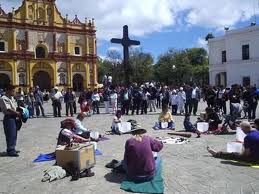
San Cristobal is the focus of the Chiapas mountainous area, and the region’s ethnic groups coincide there: native Tzotzil with Tzeltal Zoque and Choles. The attire, the type of skirt, the huipil weave and the chosen colors are clues to tell them apart. The place conserves ancient customs, like the one for Dulce Niño de Jesus or the revelry of the Fiesta Grande. It is traditional to see, in those dates, allegorical and potbellied cars; to listen to serenades or marimbas; to try sopa de pan, atole de granillo and manchamantel. Remember the street lights with red cellophane: that is where tamales are sold.
Palenque
In what seems to be an extraterrestrial apparition, vestiges of one of the most important Mayan cities are unveiled in the middle of the thick jungle. Between the humidity of the air, the greenery in the landscape and the heat that never ceases, there is no visitor who does not wonder how a civilization managed to build these constructions, under such difficult conditions. The beauty of the site is highlighted by the background landscape and makes the experience of this trip a wonderful adventure.
 Palenque is the unforgettable city lost in legend. Abandoned near the year 900 AD, it was virtually unknown until the end of the Colonial period, when the rumor spread that it lay asleep in the jungle. In 1952, Pakal’s tomb was discovered, and after that an avalanche of studies would teach us the following: it was founded around 100 BC as Lakamha, it was capital of B’akaal around 600 AD, it dominated the Usumacinta river, and its history was both tragic and glorious. It hosted the most sophisticated Mayan art, and has, among other treasures, the tomb of the Red Queen. Because of its impressive buildings, lush vegetation, and fauna diversity, Palenque it’s a Magical place.
Palenque is the unforgettable city lost in legend. Abandoned near the year 900 AD, it was virtually unknown until the end of the Colonial period, when the rumor spread that it lay asleep in the jungle. In 1952, Pakal’s tomb was discovered, and after that an avalanche of studies would teach us the following: it was founded around 100 BC as Lakamha, it was capital of B’akaal around 600 AD, it dominated the Usumacinta river, and its history was both tragic and glorious. It hosted the most sophisticated Mayan art, and has, among other treasures, the tomb of the Red Queen. Because of its impressive buildings, lush vegetation, and fauna diversity, Palenque it’s a Magical place.
Any praise uttered about Palenque will be unfair. Imagine finding a Greek Acropolis in the middle of a tropical rainforest, and now multiply it by 10, because it is estimated that 90 percent of its area is still hidden. Add to that a natural environment of irrational abundance and beauty – the Lacandon rainforest – and you will understand why, when it was declared World Heritage Site in 1987, it had taken long enough. A leading example of the Classic Mayan culture, Palenque has two thousand years of history as witness to its genius.
Villahermosa
Known originally as San Juan Bautista, the capital of Tabasco is marked by the course of the Grijalva river. Bordering Las Ilusiones lagoon, the city extends nested in green vegetation and a tropical climate. The mandatory stop for visitors used to be, and still is, La Venta Park-Museum, one of the most original museums in the world because of its thematic tour: conserving the local flora and fauna, you will find the large Olmeca heads in this natural garden, which were rescued from archaeological sites in the region.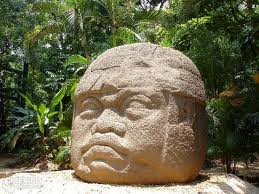
To mention archaeology in Villermosa is to say Comalcalco and La Venta. The first was the farthest point of expansion for Mayan culture to the west, and it is characterized by the use of atypical bricks as building elements. The second is a fabulous Olmeca vestige from four thousand years ago, where the most ancient pyramid in Mesoamerica is conserved, as well as countless artistic and religious pieces. The great thing is that you can visit it, at least in spirit, without leaving the city; La Venta Museum Park – an enterprise by the poet, Pellicer – rescues a great part of its treasure very close by.
Villahermosa is the entrance to the cacao route – the ancient Mayan coin that would sweeten the world as chocolate – in a tour that covers the municipalities of Nacajuca, Jalpa de Mendez, Comalcalco and Paraiso. In this Maya Chontal area, and particularly in Comalcalco, you can see cacao haciendas, La Luz or Jesus Maria. There, chocolate-making processes are rescued, and you can also visit the twelve hectares of the Cholula Farm. The seed that humanity can thank Mexico for lives under the shadow of cedar and ceiba trees.
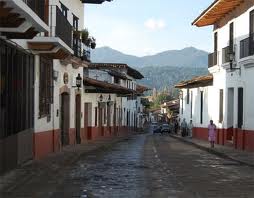 Palizada
Palizada
Palizada is a little town in Campeche whose beauty is a reminder of better times. During the period when palo de tinto, used as a red dye, and other precious woods were popular, the city grew and was filled with Colonial masonry houses – which today seem to be merely toys. Currently, Palizada is a picturesque town outside of time. In terms of nature, the Palizada river – a tributary of the Usumacinta – is very appealing for visitors, as is Terminos Lagoon, where the river ends and has been a protected area since.
The municipality where Palizada, Campeche, is found is cyclically flooded by the Palizada River and its tributaries, Viejo and Limonar. These branches of the Usumacinta River run 120 kilometers until reaching Terminos lagoon, dividing on their path a garden of mangroves that complement the extremely vast natural wealth of the area. Habitat of several birds and of manatees, Palizada will quench the ecological inclinations of any traveler seeking leisure and beauty through natural observation – by kayaking, sport fishing or swimming.
The name comes to this picturesque town in Campeche from its old lumber occupation, for this is the place from where Tinte, Campeche or Brazil wood, of historic fame, was exported. Palizada conserves this Colonial air in the French tile gable roofs, in its small streets and in the shadow of its portals, invariably framed by the lush vegetation that dominates the area. Always generous, the river by the same name even provided an atypical gift: where it meets Viejo river, it formed a small natural beach. The locals call it Playon.
Ciudad del Carmen
Today, it is an energetic city of vital importance to the oil industry, but the truth is that Ciudad del Carmen took many years to be rid of pirates and many more to become a real city. With a lovely combination in the landscape, between a lagoon and the sea, Del Carmen Island is one of the best attractions for visitors. The local gastronomy also conquers everyone.
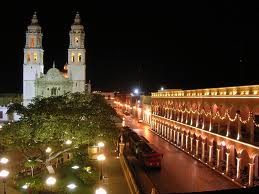 Campeche
Campeche
In Campeche, you can still breathe the sort of relaxed air you find in a small town. The city’s small center, protected by a wall, hides houses that are surprisingly well conserved. It would seem that each façade is always recently painted. The Independence Plaza is filled during the afternoons, with locals that go out for some fresh air, while the imposing cathedral is illumined as soon as night starts to fall. Not only is it the only fortified city in the country, but its downtown area was also declared as a World Heritage Site by the UNESCO.
Campeche’s walls protect, literally, the archaeological treasures in the city. At the San Miguel Fort – Campeche’s Archaeological Museum – ancient pottery and jade masks are exhibited. At the Baluarte de la Soledad, formerly the Stele Museum, you can see the famous monoliths, framed by a great collection of pieces from the Jaina Island and Calakmul. Near the city, you will find Edzna, where there are pyramids and hydraulic works. And far away: Calakmul, the huge metropolis that the Maya abandoned at the mercy of the jungle.
This night, in this part of the gulf known as the Caribbean Sea, San Francisco’s bastions in Campeche sleep in peace. Far are the buccaneers and corsairs; their dark ships, their ambition and swords. The wall has served its purpose, and today there is peace in this living museum, its old quarters a stamp of the Spanish colony. The heritage it protects is no longer Mexico’s, it belongs to humanity: on the year 1999, it was declared so. In the end, it was not Morgan, Graaf or Olones who claimed the port; it will be memory for the future, a surety for nations.
To book a trip through the Route 8 Region, please send us an email to; info@weareonetravel.com or fill in the Contact Form on the right hand side of this page.



